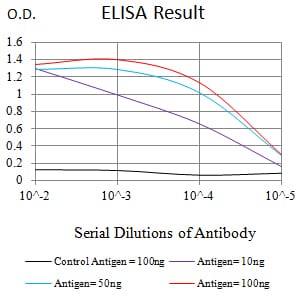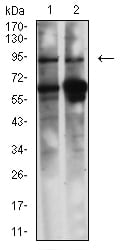


| WB | 1/500 - 1/2000 | Human,Mouse,Rat |
| IF | 咨询技术 | Human,Mouse,Rat |
| IHC | 1/200 - 1/1000 | Human,Mouse,Rat |
| ICC | 技术咨询 | Human,Mouse,Rat |
| FCM | 1/200 - 1/400 | Human,Mouse,Rat |
| Elisa | 1/10000 | Human,Mouse,Rat |
| Aliases | CDM; HCAD; LCAD; H-CAD; L-CAD; NAG22 |
| Entrez GeneID | 800 |
| clone | 6F8D2 |
| WB Predicted band size | 93.2kDa |
| Host/Isotype | Mouse IgG1 |
| Antibody Type | Primary antibody |
| Storage | Store at 4°C short term. Aliquot and store at -20°C long term. Avoid freeze/thaw cycles. |
| Species Reactivity | Human, Mouse, Rat |
| Immunogen | Purified recombinant fragment of human CALD1 (AA: 26-207) expressed in E. Coli. |
| Formulation | Purified antibody in PBS with 0.05% sodium azide |
+ +
以下是关于CALD1(Caldesmon)抗体的3篇参考文献及其摘要内容:
---
1. **文献名称**: *Caldesmon antibody as a marker for smooth muscle differentiation*
**作者**: Gimona M., et al.
**摘要**: 该研究验证了CALD1抗体在区分平滑肌细胞和其他细胞类型中的特异性,发现其在肿瘤病理学中可作为平滑肌肉瘤的诊断标志物,并揭示了CALD1在不同细胞分化阶段的表达差异。
2. **文献名称**: *Role of caldesmon in cancer progression: Insights from antibody-based profiling*
**作者**: Helfman D.M., et al.
**摘要**: 通过CALD1抗体对多种癌症组织进行免疫组化分析,发现CALD1表达水平与肿瘤侵袭性和转移相关,提示其可能作为癌症预后标志物,并参与调控细胞迁移和细胞骨架重塑。
3. **文献名称**: *Caldesmon isoforms in vascular remodeling: Detection using isoform-specific antibodies*
**作者**: Wang Z., et al.
**摘要**: 研究开发了针对CALD1不同亚型的特异性抗体,发现高钙调蛋白结合型(h-CALD1)在血管平滑肌细胞表型转换中起关键作用,为动脉粥样硬化和血管损伤修复机制提供了新见解。
---
以上文献涵盖了CALD1抗体在疾病诊断、癌症研究和血管生物学中的应用。如需具体文章链接或更详细内容,可进一步通过PubMed或期刊数据库检索。
The CALD1 antibody targets caldesmon, a protein encoded by the CALD1 gene, which exists as two major isoforms: high-molecular-weight (h-CALD1) and low-molecular-weight (l-CALD1). Caldesmon plays a critical role in regulating cytoskeletal dynamics and smooth muscle contraction by modulating actin-myosin interactions. The h-CALD1 isoform is predominantly expressed in smooth muscle cells, where it stabilizes contractile filaments and mediates calcium-dependent relaxation. In contrast, l-CALD1. a splice variant lacking a portion of the C-terminal domain, is widely expressed in non-muscle cells and participates in processes like cell migration, proliferation, and stress fiber organization. Dysregulation of caldesmon has been linked to vascular disorders, fibrosis, and cancer progression, particularly in tumor invasion and metastasis due to its influence on extracellular matrix remodeling.
CALD1 antibodies are essential tools for studying these isoforms' distinct functions in physiological and pathological contexts. They are widely used in techniques such as Western blotting, immunohistochemistry, and immunofluorescence to assess protein expression, localization, and post-translational modifications. Researchers also employ CALD1 antibodies to explore caldesmon's interactions with binding partners like actin, tropomyosin, and myosin, shedding light on its regulatory mechanisms. Commercially available antibodies vary in specificity, often distinguishing between isoforms or phosphorylation states. Validation methods, including knockout controls or peptide competition assays, are crucial to ensure accuracy, as cross-reactivity with unrelated proteins has been reported. These reagents continue to support advances in understanding caldesmon's dual roles in maintaining cellular homeostasis and driving disease mechanisms.
×